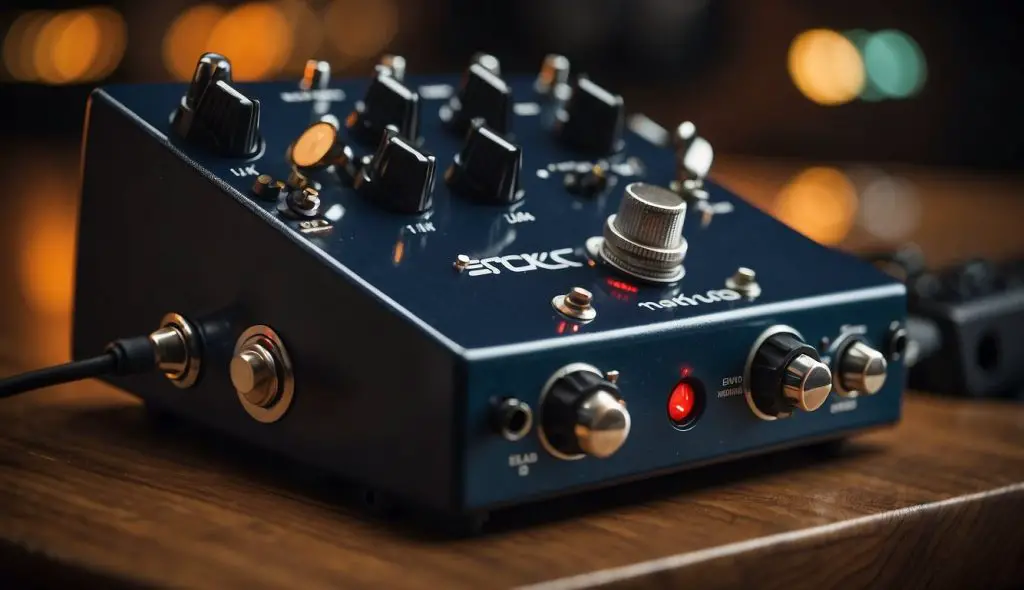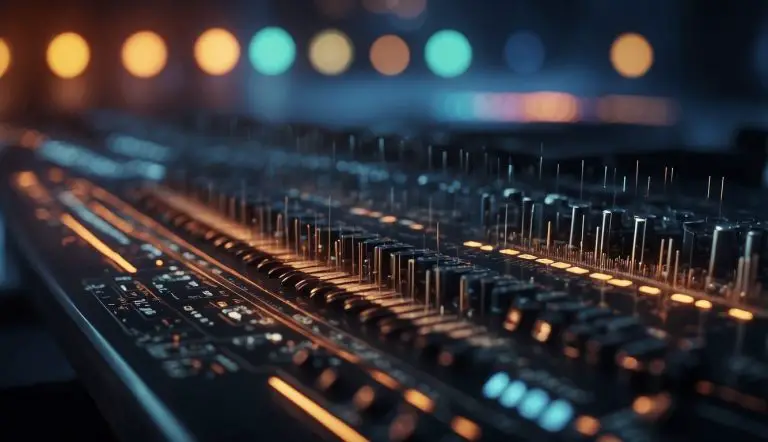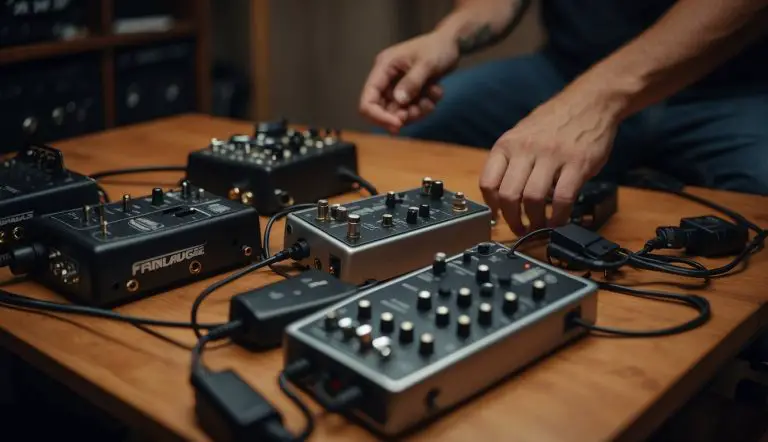What are Modulation Effects? – A Beginner’s Guide
Modulation effects are a popular category of audio effects. They are used in music production to create unique sounds and textures.
Modulation effects are used to alter the sound of a signal by modulating one or more aspects of the signal, such as its amplitude, frequency, or phase.
These effects can be used to create a wide range of sounds, from subtle textures to dramatic soundscapes.

The fundamentals of modulation involve altering the characteristics of a sound signal. Modulation effects can be applied to different aspects of the sound, such as its pitch, volume, or tone. By modulating different aspects of the sound, modulation effects can create a range of unique and interesting sounds.
Common modulation effects include chorus, flanger, phaser, tremolo, and vibrato. Each of these effects modulates a different aspect of the sound, creating a unique effect. For example, chorus and flanger effects modulate the pitch of the sound, while phaser effects modulate the phase of the sound. Tremolo and vibrato effects modulate the volume and pitch of the sound, respectively.
Key Points
- Modulation effects are used to alter the sound of a signal by modulating one or more aspects of the signal, such as its amplitude, frequency, or phase.
- Common modulation effects include chorus, flanger, phaser, tremolo, and vibrato, each of which modulates a different aspect of the sound.
- Modulation effects can be used to create a wide range of sounds, from subtle textures to dramatic soundscapes.
Table of Contents
Fundamentals of Modulation
Understanding Modulation
Modulation is the process of varying one or more properties of a periodic waveform, known as the carrier signal, with a modulating signal that typically contains information to be transmitted. The modulating signal can modify the frequency, amplitude, or phase of the carrier signal, resulting in a modulated signal with characteristics different from the original carrier signal.
Types of Modulation Effects
There are several types of modulation effects that can be applied to a carrier signal, including:
- Amplitude Modulation (AM): In AM, the amplitude of the carrier signal is varied by the modulating signal. This results in a modulated signal with sidebands, which are frequencies located above and below the carrier frequency.
- Frequency Modulation (FM): In FM, the frequency of the carrier signal is varied by the modulating signal. This results in a modulated signal with sidebands, which are frequencies located above and below the carrier frequency.
- Phase Modulation (PM): In PM, the phase of the carrier signal is varied by the modulating signal. This results in a modulated signal with sidebands, which are frequencies located above and below the carrier frequency.
- Depth Modulation: Depth modulation is a type of amplitude modulation where the amplitude of the modulating signal is varied, resulting in a modulated signal with varying depth.
- LFO Modulation: Low-frequency oscillator (LFO) modulation is a type of modulation where a low-frequency oscillator is used to modulate the carrier signal. This results in a modulated signal with a varying frequency, amplitude, or phase.
- Oscillator Modulation: Oscillator modulation is a type of modulation where an oscillator is used to modulate the carrier signal. This results in a modulated signal with a varying frequency, amplitude, or phase.
In summary, modulation is a powerful tool used to modify the properties of a carrier signal. By varying the frequency, amplitude, or phase of the carrier signal with a modulating signal, we can create a modulated signal with characteristics different from the original carrier signal.
Common Modulation Effects
Modulation effects are a type of audio processing that manipulate the sound of an audio signal by altering its frequency, phase, and amplitude characteristics. These effects are used to add depth, warmth, and movement to the sound, making it more interesting and dynamic. In this section, I will discuss some of the most common modulation effects and their characteristics.
Chorus and Its Characteristics
Chorus is a modulation effect that creates a thick and lush sound by duplicating the original signal and adding a slight delay to each copy. The delayed signals are then modulated in pitch and amplitude, creating a swirling effect that mimics the sound of multiple instruments playing in unison. The result is a rich and spacious sound that can be used to add depth and dimension to guitars, keyboards, and vocals.
Some characteristics of chorus include:
- A wide and spacious sound
- A slight pitch shift that creates a “shimmering” effect
- A slow modulation rate that mimics the sound of a choir or ensemble
Flangers and How They Work
Flangers are another type of modulation effect that create a sweeping sound by duplicating the original signal and modulating it with a short delay time. The delayed signal is then mixed back with the original signal, creating a comb-filtering effect that produces a “whooshing” sound. Flangers are commonly used on guitars, drums, and synthesizers to add movement and texture to the sound.
Some characteristics of flangers include:
- A sweeping and swirling sound
- A short delay time that creates a “jet-like” effect
- A high feedback level that can create a resonant peak in the frequency spectrum
Phasers and Phase Shifting
Phasers are a type of modulation effect that create a sweeping sound by splitting the audio signal into two paths, modulating one path with a phase-shifted signal, and then mixing the two signals back together. The result is a complex and swirling sound that can be used to add movement and depth to guitars, keyboards, and drums.
Some characteristics of phasers include:
- A sweeping and swirling sound
- A phase-shifted signal that creates a “swirling” effect
- A high feedback level that can create a resonant peak in the frequency spectrum
Tremolo and Vibrato Effects
Tremolo and vibrato are two modulation effects that are often used interchangeably, but they have distinct characteristics. Tremolo is a modulation effect that creates a rhythmic variation in the amplitude of the audio signal, while vibrato is a modulation effect that creates a rhythmic variation in the pitch of the audio signal. Both effects can be used to add movement and depth to guitars, keyboards, and vocals.
Some characteristics of tremolo and vibrato include:
- A rhythmic variation in amplitude or pitch
- A slow or fast modulation rate
- A depth control that adjusts the intensity of the effect
Technical Aspects of Modulation
Signal Path and Modulation
When it comes to signal modulation, it is important to understand the signal path. The signal path refers to the flow of the electrical signal from the source to the output. Modulation is the process of changing the characteristics of a signal in order to transmit information. This can be achieved by varying the amplitude, frequency, or phase of the signal.
In electronics, a carrier signal is used to transmit the information. The carrier signal is a high-frequency signal that is modulated by the information signal. The information signal is usually a low-frequency signal that carries the actual information.
Feedback and Resonance
Feedback is an important aspect of modulation. Feedback control is used to maintain the desired modulation characteristics of the signal. This is achieved by using an all-pass filter and a delay line. The all-pass filter allows the feedback signal to be in phase with the input signal, while the delay line introduces a time delay to the feedback signal.
Resonance is another important aspect of modulation. Resonance occurs when the frequency of the input signal matches the natural frequency of the system. This can lead to amplification of the signal. In order to prevent unwanted resonance, it is important to use feedback control.
Waveforms and LFOs
Waveforms play a crucial role in modulation. A waveform is a graphical representation of the shape of a signal. There are several types of waveforms, including sine, square, triangle, and sawtooth. Each waveform has its own unique characteristics and is used for different purposes.
Low-frequency oscillators (LFOs) are another important aspect of modulation. LFOs are used to modulate the carrier signal at a low frequency. This creates a rhythmic effect that is often used in music. LFOs can be used to create a variety of different effects, including vibrato, tremolo, and wah-wah.
Modulation Effects in Music Production
Modulation effects are an essential part of music production. They help to create depth, dimension, and movement in a track. In this section, I will discuss some of the iconic uses of modulation in music history, as well as how modulation is used in the studio and live settings.
Iconic Uses in Music History
The Beatles are known for their innovative use of modulation effects in their music. In “Tomorrow Never Knows,” John Lennon used a Leslie speaker to create a swirling, psychedelic effect on his vocals. The song also features a tape loop that is modulated with a flanger effect, creating a hypnotic, otherworldly sound.
Pink Floyd’s “Run Like Hell” features a heavily modulated guitar riff that creates a sense of urgency and tension in the song. The Police’s “Walking on the Moon” uses a chorus effect to create a shimmering, ethereal sound on the guitar.
Modulation in the Studio and Live Settings
Modulation effects can be used in both the studio and live settings to enhance a performance. In the studio, modulation effects can be used to add depth and dimension to a mix. For example, a flanger effect can be used on a vocal track to create a sense of movement and space.
In a live setting, modulation effects can be used to add excitement and energy to a performance. Eddie Van Halen’s use of a phaser effect on his guitar in “Ain’t Talkin’ ‘Bout Love” is a great example of how modulation effects can be used to create a distinctive sound.
DAWs (Digital Audio Workstations) such as Ableton Live and Logic Pro X have a wide range of modulation effects that can be used to enhance a track. These effects include chorus, flanger, phaser, and tremolo, among others.
Frequently Asked Questions
How do modulation effects alter the sound of a guitar?
Modulation effects alter the sound of a guitar by adding movement and depth to the sound. They do this by modulating the sound wave, which means changing its shape in a specific way.
This can create a range of effects, from subtle to extreme, depending on the settings of the effect pedal. Modulation effects can be used to create a variety of sounds, from shimmering chorus to pulsing tremolo.
Can you list some common types of modulation pedals?
There are several common types of modulation pedals. These include chorus, phaser, flanger, tremolo, and vibrato. Each of these pedals produces a unique modulation effect that can be used to create different sounds and textures.
What’s the difference between time-based and modulation effects?
Time-based effects are effects that are based on the timing of the signal, such as delay and reverb. Meanwhile, modulation effects are effects that change the shape of the signal, such as chorus and phaser.
While both types of effects can be used to create movement and depth in the sound, they do so in different ways.
Is tremolo considered a type of modulation effect?
Yes, tremolo is considered a type of modulation effect. Tremolo modulates the volume of the sound wave, creating a pulsing effect that can be used to create a variety of rhythmic patterns.
In what ways do modulation effects impact music production?
Modulation effects can have a significant impact on music production by adding movement and depth to the sound. They can be used to create a variety of sounds and textures, from subtle to extreme, and can be used to enhance the emotional impact of a song.
Are there modulation effects that combine multiple modulations in one pedal?
Yes, there are modulation effects that combine multiple modulations in one pedal. These pedals are often referred to as “multi-mod” pedals.
Multi-mod pedals can produce a wide range of sounds and textures by combining different modulation effects. Some examples of multi-mod pedals include the Strymon Mobius and the Chase Bliss Audio Warped Vinyl.




